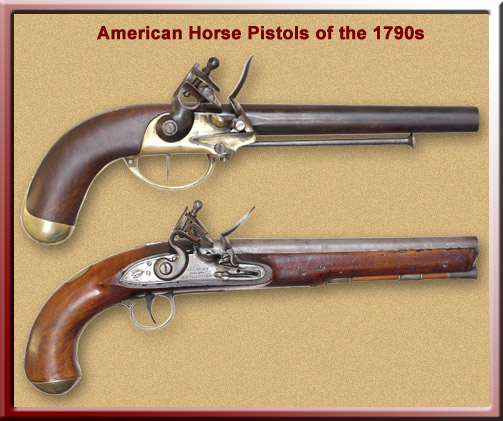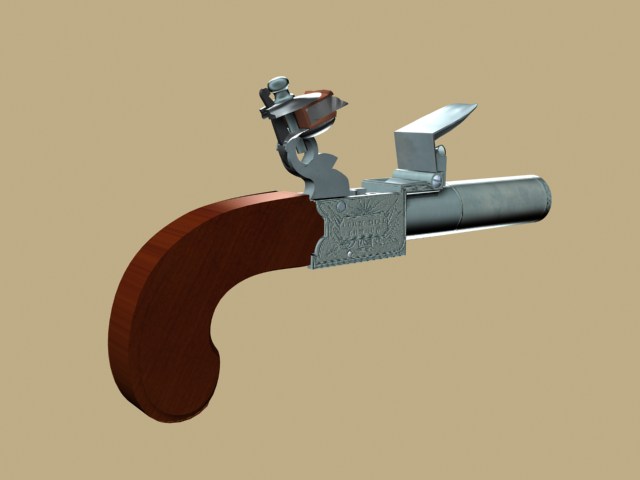Horse Pistols
They were called “horse pistols” because they usually were issued in pairs with a set of connected holsters designed to be draped over the pommel of a saddle. Horse pistols weighed several pounds each, and were so long they could not comfortably be carried at the hip. In fact, the belt holsters that we commonly associate with cowboys were not used in the era of Meriwether Lewis and William Clark.
In 1803, Lewis picked up a set of two horse pistols from the Schuylkill Arsenal in Philadelphia, where records indicate there were several hundred pairs on hand. The standardized U.S. military pistol of that period was the Model 1799 single-shot flintlock gun made under contract with North & Cheney of Berlin, Connecticut. This would most likely be the weapon Lewis chose because it could use the same .69 caliber ball as the standard U.S. military musket. It was 14½ inches long overall, and weighed three pounds.
In addition to the North & Cheney pistols, Lewis could have chosen from over 100 horseman’s pistols of an earlier model on hand in Philadelphia’s Schuylkill Arsenal in 1803. In the late 1790s the U.S. Army ordered pistol barrels, locks and stocks from both European and domestic sources. They let contracts-for-assembly to various regional gunsmiths, supplied them with locks, stocks and barrels; the craftsmen returned finished pistols and charged only for their labor and incidental parts. The second pistol illustrated above represents these assembly-contract weapons. They were small caliber than the North & Chaney, so many historians conclude that Captain Lewis would have chosen the North & Cheney because of the convenience of interchangeability of bullets with the standard Army musket.
Two Medicine River Encounter
Early on the morning of 27 July 1806, while camped on the Two Medicine River in the upper Marias River basin with his three companions and eight young Piegan men they had met on the previous afternoon, Lewis was awakened by a shout from Drouillard: “damn you let go my gun!” The captain quickly learned that the Indians had seized all the men’s weapons. He later recalled:
I reached to seize my gun but found her gone, I then drew a pistol from my holster and terning myself about saw the indian making off with my gun. I ran at him with my pistol and bid him lay down my gun which he was in the act of doing when the Fieldses returned and dew up their guns to shoot him which I forbid a he did not appear to be about to make any resistance or commit any offensive act, he droped the gun and walked slowly off.
Meanwhile, rest of the Indians were making off with the Americans’ horses, a deed of even more threatening consequences than the theft of their guns. When Lewis called the horse-capturers’ bluff, one of them took cover and called to the other. The latter turned to face Lewis, who shot him in the belly. The Indian returned fire, barely missing Lewis’s head, then crawled behind a nearby rock. Lewis, having only one pistol in hand, and with his shot pouch still yards away, turned and “returned leasurely towards camp.”[1]See also Fight on the Two Medicine.
Since Lewis and his men had been on horseback, and he drew the pistol from a holster, it is almost certain that the weapon was one of the “horse pistols” he had obtained from the arsenal at Philadelphia.
Pocket Pistols
This pocket pistol and the two animations below are based on a .50 caliber flintlock pistol made by Philip Bond, 45 Corn Hill, London, sometime between 1794 and 1816.
Loading a Pocket Pistol
Animation by Bob Gilman
Firing a Pocket Pistol
Animation by Bob Gilman
One of the surviving receipts of the Lewis and Clark expedition reads, “May 21st 1803 Bot. of Robert Barnhill 1 Pair Pocket Pistols, Secret Triggers $10.” Barnhill endorsed the receipt, “The within Pistols were delivered by me to Captn. Meriwether Lewis.” Barnhill had a gun shop at 63 North Second St. in Philadelphia. His newspaper advertisement of 1 January 1803, lists his offerings of rifles and musket powder, buck shot, goose shot, English and Dutch fowling pieces, holster and pocket pistols, flints, powder flasks, shot belts, and more. Captain Lewis bought the pocket pistols.
It was the normal practice for gunshop owners to import pocket pistols from England and have their shop name engraved on the pistols, but the one shown here was made in London by some member of the famous Bond family of gunsmiths. Small pocket pistols weren’t manufactured in America until Henry Deringer produced his eponymous pistols in the 1830s.
Judging from the thousands of specimens still available, these small pocket pistols must have been carried by a great many men and women in England and America. These small flintlock pistols, which were usually sold in pairs, were about six inches long, fired a single ball of .40 to .50 caliber, and could be had either with a normal outside trigger or a concealed trigger. Lewis chose the model with a concealed, or “secret,” trigger. This feature made the gun more streamlined and less prone to snag when withdrawn from the pocket.
For loading, the barrel would be unscrewed and a powder charge and ball placed in a cavity in the breech. The ball would be large enough to fit snugly in the bore so that it wouldn’t roll out of the barrel. After replacing the barrel, a small charge of fine powder would be poured into the pan, the frizzen lowered, and the safety pushed forward to lock the frizzen and hammer in the half-cock position. To fire, the safety would be retracted and the hammer would be cocked. The cocking of the hammer caused the trigger to snap down into the ready position.
At Camp River Dubois on 30 March 1804, Clark evidently loaded “a small pr Pistols” to display as a warning, should there be any trouble when the results of the court martial of Shields, Colter and Robert Frazer were announced. (Shields and Colter relieved the tension by apologizing for their misconduct.) These could have been the pocket pistols with disappearing triggers that Lewis had purchased with government funds, or the horse pistols he had requisitioned from the armory. Or, perhaps Clark had his own pistols.
So far, historians have been unable to determine whatever became of the concealed-trigger pistols.
Notes
| ↑1 | See also Fight on the Two Medicine. |
|---|
Experience the Lewis and Clark Trail
The Lewis and Clark Trail Experience—our sister site at lewisandclark.travel—connects the world to people and places on the Lewis and Clark Trail.
Discover More
- The Lewis and Clark Expedition: Day by Day by Gary E. Moulton (University of Nebraska Press, 2018). The story in prose, 14 May 1804–23 September 1806.
- The Lewis and Clark Journals: An American Epic of Discovery (abridged) by Gary E. Moulton (University of Nebraska Press, 2003). Selected journal excerpts, 14 May 1804–23 September 1806.
- The Lewis and Clark Journals. by Gary E. Moulton (University of Nebraska Press, 1983–2001). The complete story in 13 volumes.



